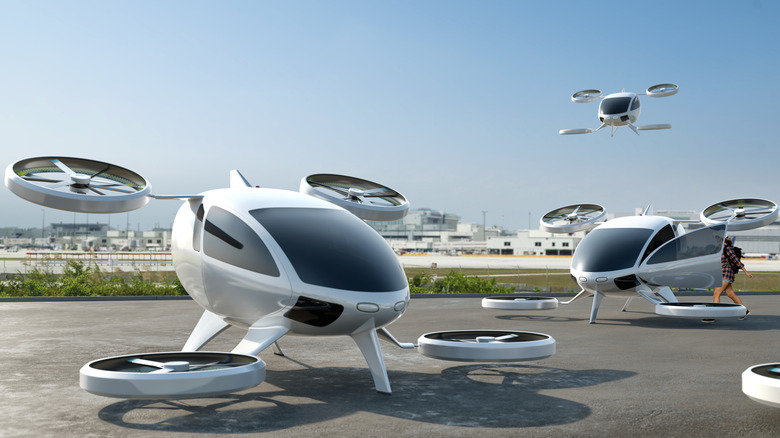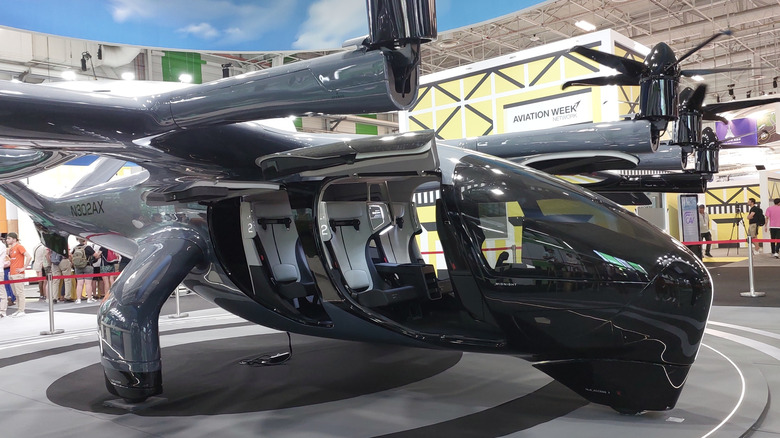Florida's Busiest Airport Is Working With The FFA To Get Flying Taxis By 2028
The year is 2028. You touch down at Orlando International Airport, already wearing mouse ears in anticipation of your long-awaited vacation. At baggage claim, you pull out your phone to order a ride to your hotel. Your suitcase arrives, and as you wheel it out into the beaming sunshine, you hear a soft whirr overhead. Your taxi descends from the sky — like a drone, but bigger — sleek and futuristic-looking, with plush seats and ample storage space. You swing your luggage inside and climb aboard, buckling in while the mini-heli lifts off, beating miles of traffic on Interstate 4 as you glide toward Disney World. It's the quintessential dream of the future: Flying cars have fascinated the world since at least the 1960s, when "The Jetsons" aired its version of a skybound commute. Despite all the travel technology humanity has pioneered — from Wi-Fi on planes to AI-powered travel search engines — flying cars still haven't taken off. The furthest we've gotten is drone deliveries. Now, however, that's changing. Orlando International Airport (MCO) could become the first U.S. airport to offer air taxis by 2028.
Flying taxis, or advanced air mobility (AAM), are like miniature helicopters, taking off vertically while utilizing overhead propellers. They're also fully electric. Several private companies are currently flight-testing prototypes, aiming for FAA certification within the year. "It probably won't fold down and fit into a suitcase like in 'The Jetsons,'" joked Brad Friel, Senior Vice President of Planning and Environmental at Greater Orlando Aviation Authority (via Spectrum News 13). But the plan is for the vehicles to eventually be autonomous. While early flights will be piloted, the long-term goal is for remote, ground-based pilots to control them. This hybrid system, according to Friel, could increase range and access to more destinations, up to a 200-mile radius from MCO.
Different versions of the flying taxi are in development
Beyond their utility as a taxi service, AAMs could also be used for excursions and vacation packages, adding to the growing list of things to do around Orlando that aren't just Disney World. Orlando is, after all, a gateway to southwest Florida. It's home to a myriad of theme parks and nature preserves, welcoming around 75 million visitors annually. Adding AAMs to the airport is estimated to create 280,000 jobs by 2035 and generate $115 billion in annual revenue for MCO.
Currently, Joby and Archer, two companies developing AAMs with electric vertical takeoff and landing (eVTOL) capabilities, are undergoing rigorous testing to ensure they can safely operate without disrupting other air traffic. Joby, a California-based eVTOL company, is testing its S4, which can reach up to 200 "quiet" miles per hour with zero emissions, thanks to its tilt-rotor propellers that reduce weight and assist with both lift and cruise. It can carry four passengers in addition to its pilot. Archer, another California company, is developing the Midnight, which uses separate propellers for lift-off and cruising. This adds weight and limits top speed to 150 mph, but enables a different flight profile. A third electric aerial company, Lilium, is collaborating with the city of Orlando and its surrounding suburbs to test its AAM — a jet-style vehicle with wings. Additional infrastructure, like "vertiports," will also need to be built to dock, store, and service these flying taxis.
In 2021, Joby stated that it hoped to start ride prices around $3 per mile, similar to a taxi or app-based rideshare service, but eventually drop that price even lower to stay competitive with ground transportation (via WLRN). The future may not be exactly how "The Jetsons" imagined it, but it's finally coming to fruition.

